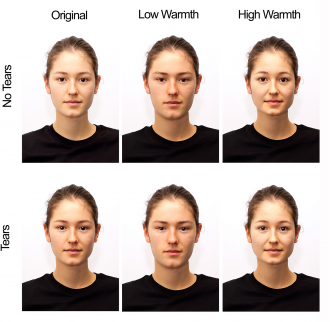Media release
From: PLOS“Crocodile tears” might be most believable for people least expected to cry
Contextual factors may affect if tears are perceived as sincere or manipulative tears, including the gender and perceived warmth of the crier
A new study adds to evidence suggesting that people’s perceptions of others’ tears as sincere or manipulative likely depends on a variety of contextual factors. The findings suggest tears may be perceived as more honest when shed in non-manipulative social situations and by people who are less expected to cry. Monika Wróbel of the University of Lodz, Poland, and colleagues present these findings in the open-access journal PLOS One on July 16, 2025.
Emotional tears are often perceived as sincere social signals, perhaps because it is difficult to cry on demand. In contrast, widespread belief holds that tears can also be shed strategically to manipulate others; i.e., “crocodile tears.”
However, few studies have systematically explored the circumstances in which tears are perceived to be sincere or not. To gain deeper insight, Wróbel and colleagues conducted experiments in which thousands of participants shared their perceptions of faces in photographs, some of which had been edited to appear tearful. The faces varied in their conveyed warmth and were presented in hypothetical situations that were manipulative or not—for instance, the person in the photo is trying to cut in line to see a doctor (manipulative) versus waiting to see a doctor and speaking with a receptionist (non-manipulative). Participants also completed a questionnaire assessing their own personality traits.
Analysis of participants’ responses showed that, while tears had a very small overall effect on how participants perceived the honesty of people in the photos, certain contextual factors did appear to influence the strength of this effect.
Most notably, tears tended to increase participants’ perceptions of honesty more strongly for female photo subjects with lower warmth ratings and for men, who are typically perceived as less warm. This suggests the possibility that shedding tears might be more beneficial for people who are less expected to cry. Tears were also perceived as more honest in the context of non-manipulative situations.
Overall, the findings support the idea that context is key for the perception of tears as honest or not, with multiple factors affecting the context. Additional research is needed to disentangle these factors and their effects.
The authors add: “Our studies showed that tears are not universally seen as a sincere social signal, because their perceived genuineness depends on who is crying and in what situation. Most importantly, we found that tears might be more socially beneficial (that is, perceived as more honest signals motivating others to support the crier) when shed by people less expected to do so (for instance, by men or low-warmth people). Possibly, when men or low-warmth people tear up, which is quite unexpected, observers assume that there must be a genuine reason to do so.”
“The biggest challenge in studying the social effects of tears is choosing the right stimuli. In our research, similar to most studies in this field, we used pictures of individuals with digitally added tears. However, crying is a complex, multifaceted emotional expression that consists of not only tears but also gestures, vocalizations, or facial muscle movements. This calls for improved, more ecologically valid manipulations in the future.”



